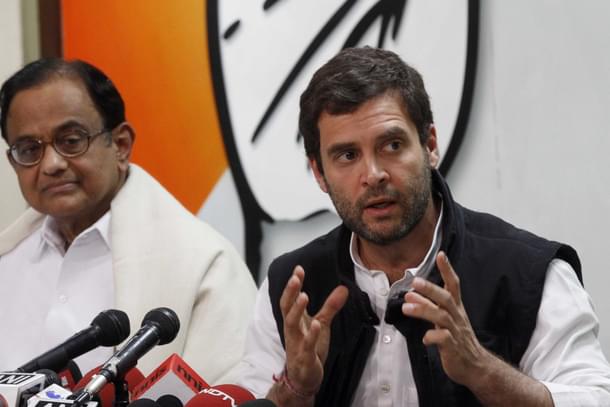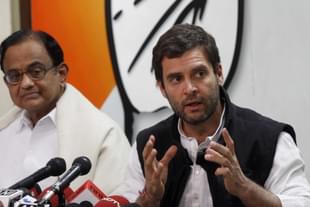Politics
Rahul Gandhi’s Fiscal Adventurism: Your Promises, Our Money?
Bindu Dalmia
Apr 04, 2019, 12:13 PM | Updated 12:13 PM IST
Save & read from anywhere!
Bookmark stories for easy access on any device or the Swarajya app.


The 2019 general elections would be defined as one of the most schismatic polls in the annals of Indian history. Never before has the polity been more divided as it stands between Narendra Modi haters versus admirers, between chowkidars versus pariwars, and between liberals versus perceptions of majoritarian tyranny.
Over the past 18 months, alternate thematic political narratives have traded places to dominate electoral issues. According to Times Mega Polls, Congress’ attempt to strike a chord on Rafale drew just 17.51 per cent traction.
So, electoral issues have subsequently narrowed down to Modi’s successful delivery of his development agenda plus nationalistic populism against Rahul Gandhi’s welfarist populism. Though it’s early days, gauging from the mood of the nation 10 days before polling, it seems more likely to be Modi 2.0 than a Rahul 1.0.
Populism comes in many genres: ideological, religious, nationalistic, the elite versus the downtrodden etc, and it all depends on which issues ultimately gain primacy. The 2019 Authoritarian Populism Index points to a progressive increase in support for populist parties across Europe and the US, and India is no exception. So, will Congress’ ‘pop-populism’ hold sway over the Bharatiya Janata Party’s (BJP’s) nationalistic populism?
The Congress party’s minimum guarantee proposal has set the cat amongst the political pigeons in a race towards auctioneering welfarist schemes. The higher a political party bids for minimum income support or minimum income guarantee schemes, the higher is its resonance with the underprivileged and unorganised sector. Does Gandhi’s political desperation at competitive populism, as also his decision to contest from two seats, in some ways concede Modi is set for a second term?
However, the NYAY scheme would still have to be factored in as the opposition’s trump card to force a relook even post-government formation in May, as the genie has been unleashed. Economists estimate NYAY could cost between Rs 3.6 lakh crore and Rs 7.2 lakh crore, taking the fiscal deficit to a whopping 8 per cent of the gross domestic product (GDP), leading to a hike in direct income and corporate taxes, and imbalancing fiscal prudence.
Gauging from the recent interview to Arnab Goswami of Republic TV, the Prime Minister sounded every bit the victor of 2019 in a ‘done-deal’ kind of confidence he exuded. The big shift to the likely second coming of Modi was in his taking a leaf out of his mentor Atal Bihari Vajpayee’s inclusive dharma of governance by handing out an olive branch to Mayawati and Mamata Banerjee relayed through the Republic TV .
So, if a Modi win is a foregone conclusion, why are we obsessing about irresponsible populism of the kind Rahul Gandhi has announced, or what state satraps in power are lavishly promising voters, oblivious of its burden on state or central coffers? Because prodigal populism will lay the foundations for the next financial crisis, at a time when pessimists forecast a second global financial crisis can hit sometime next year.
As global growth loses momentum, with the governments’ debt-to-GDP ratio already at 68.4 per cent, it leaves limited room to act if there is a downturn. “This necessities striking a balance between national debt and social objectives while addressing the issue of income inequality,” according to International Monetary Fund chief Christine Lagarde’s prescription.
India has a pool of amongst the finest economists who know all too well that gharibi cannot end through interim measures like reservations, loan waivers and income support. Sustainable economic goals in mitigation of poverty can only be achieved when the marginalised get the tools to remove asymmetric imbalances through universal inclusion in basics, as in education, healthcare and housing, all of which are also catalysts for increase in economic activity that spurs job creation.
Freebies are the fall backs for governments when the economy does not grow organically. In rewriting the rules for an egalitarian free market economy, at what cost does Rahul Gandhi and his left-leaning think-tank comprising Amartya Sen, P Chidambaram, Raghuram Rajan and French economist Thomas Picketty hope to fund NYAY, which will be a recurring annual expenditure and not a one-time dole? Will it be funded by increasing taxes, borrowing more, or cutting down spending? With the rise of competitive populism, do we infer that “political parties are now giving up on the endeavour to have a development state in favour of a compensatory state?” That is the vital question.
The Rs 72,000/annum Congress poll promise is slowly entering gullible voters’ conversations in the Hindi heartland. Voters must question the United Progressive Alliance’s (UPA’s) 10-year rule from 2004 to 2014, when Gandhi held proxy power to effectuate transformative economy policies. Why then did he not assert himself as crusader for the poor?
Indians must dread the budget of June 2019 should a new Congress-led government comes to power, because the dispensation of ‘nyay’ is a cost that will be a heavy burden on taxpayers, especially the middle class. Poverty eradication needs a more holistic approach to mainstream the marginalised at a faster pace.
For that, India needs to increase its tax-payer base of a mere 3 per cent; lower dependence on agri-income to 3 per cent of GDP in conformity with global standards; increase outlays on education close to 10 per cent GDP, and roll out students who are future-ready for absorption; facilitate market dynamics of demand-supply so industry responds by expanding capacity and begins to absorb higher workforce.
Post government formation in May, the state must play facilitator to widening the economic pie. Globally, the political power of oligopolies has determined the rules of markets and governance written in their favour, leaving the poorer strata ‘excluded’ for far too long. Whichever government comes to power, there is no alternative to bridging inequalities through raising taxes on the super-affluent, with few avenues left to tap into.
The options are: raising agricultural income exceeding a certain threshold; increasing personal taxation above the 1 crore slab; as also mandating a progressive increase in corporate social responsibility spend in proportion to corporate revenue, in order to raise government earnings and utilise the redistributive effects of taxation more effectively.
Any which way, the first six months of the next government will call for tough decisions on taxes, top-most prioritisation on job creation and mitigation of the farm crisis, and re-accelerating the pace of structural reforms again.




